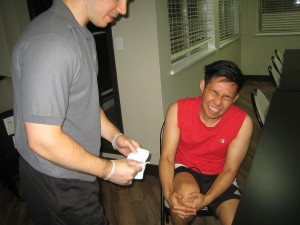Those who engage on skiing are at risk for skiing injuries if they are not skilled enough or not using appropriate gear. Several injuries can occur and the most common are the knee injuries, especially the anterior cruciate ligament. When skiing, an individual puts their arms forward to break a fall, thus shoulder injuries can also occur such as sprains and dislocations. Even fractures around the lower leg and shoulders are common. Serious injuries involving the head can also occur in skiing.

The best way to prevent skiing injuries is to utilize the appropriate equipment as well as selecting ski courses that suits your experience and skill level. It is important to enroll in ski lessons so that you will learn how to fall safely and correctly in order to minimize the risk for injuries.
Preparation when skiing
Initially, if you want to ski, it is important that you are in good physical condition. In case you are out of shape, it is recommended to use ski courses that are safe and slowly move on to the challenging trails. Majority of skiing injuries typically occur at the end of the day where individuals overdo themselves just to finish their last run. Possible injuries can be prevented if you are in good shape and knowing when it is time to rest.
Just like in any sport, warming up is important before skiing. If you do not warm up, you are at higher risk for injuries. You can even perform slow ski runs to finish your warm up routine.
Always hydrate the body by drinking adequate amounts of water. Make sure that you drink before, during and after skiing. Understandably, following the rules in the ski resort is also important. In doing so, your risk for getting injured is minimized.
Proper gear and equipment
- Always wear several layers of loose, light and water and wind resistant clothing for protection and warmth while skiing. By layering, it allows you to accommodate the constantly changing temperature of your body.
- Inspect the binding of the skis you will use before skiing. Always remember that the bindings should be adjusted properly to your weight and height.
- Rent or purchase boots and bindings that are adjusted, tested and maintained by ski shops.
- Wear protective gear such as a helmet and goggles specifically for skiing.
Ensuring safety while skiing
As a safety measure, it is advisable to stay on the marked trails when skiing. Avoid areas prone to avalanche such as steep hillsides with minimal vegetation. Be on the lookout for rocks as well as patches of ice on the trails.
Pay attention to warnings regarding upcoming storms and drastic drop in the temperature.
[youtube url=”http://www.youtube.com/watch?v=FP77Md8v390″]Preparation for skiing injuries
When skiing, it is best to ski with a partner and stay within close perimeter. In case you lose sight of your partner, simply stop and wait.
If an individual is suffering from hypothermia or frostbite, it is important to seek shelter and get medical care right away.
